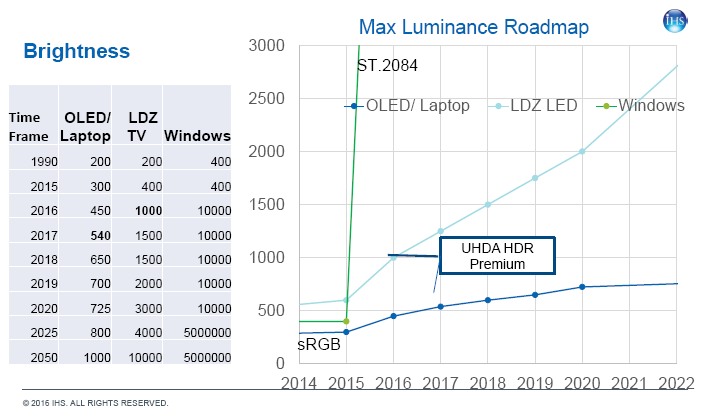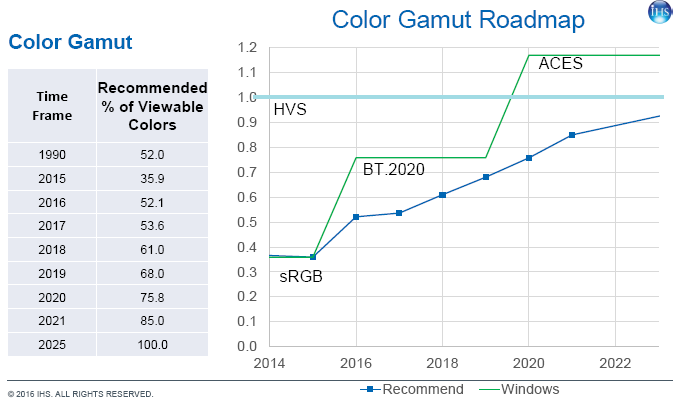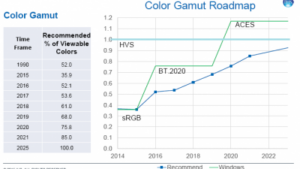The Business Conference was opened with introductions by Yong-Seog Kim, President of SID and Ben Keen of IHS.
Keen introduced IHS which runs the Business Conference and which has acquired seven companies to build up its business, including iSuppli (which had Stanford Resources), Screen Digest, DisplayBank and, of course, DisplaySearch.
The first speaker was Chas. Boyd of Microsoft, who is a Product Manager for Windows Silicon Graphics and Media.
He started by saying that displays are going through a development phase especially with high dynamic range (HDR) and wide colour gamut (WCG), but the PC industry is also interested in this even if the lead has been taken by TV. He also planned to talk about GPU shaders.
There has been huge innovation in DirectX and things improved radically in graphics between 1993 and 2003 – and content and hardware companies won Emmy awards for thie development. Microsoft is confident that this was because of the virtuous circle that the company worked to that kept pressure on to keep things improving. Boyd went through the steos virtuous cycle and said it would be good to have the same virtuous cycle for displays.
The steps are :
- Identify what users want and will pay for (goals) – e.g. HDR, Contrast, Gamut
- Define metrics for technologies customers want e.g. MaxLuminance, LDZs, %HVS
- Define benchmarks for key metrics that users want e.g. Certifications and logos
- Remove any barriers or limits in the system e.g Chicken/egg, situations etc.
- Develop standards/protocols for interoperability e.g. HDMI, BluRay, Windows, Web
- Make sure customers are aware e.g. Review sites
- Turn the ecosystem loose!
Customers want HDR, contrast and wider gamuts. The appropriate metrics are the maximum luminance, the number and quality of local dimming zones and the percentage of the colour gamut of the human visual system. There is work going on to decide what is needed and how to measure the parameters. Certification and logos need sorting There are barriers to remove and standards are being worked on.
Looking at the phenomena that customers want to see, such as brightness, a typical good monitor only goes to 400 cd/m² which is good enough to substitute for paper in office lighting. However, there is a long way to go if you want to give the impression of the monitor as a window onto the world. There is a lot of headroom for innovation. Although there are concerns about issues such as power consumption, in reality, very, very bright images tend to only occupy a small part of the display.
 Microsoft’s HDR Expectations are for much higher brightness from LCD than OLED
Microsoft’s HDR Expectations are for much higher brightness from LCD than OLED
Games developers and designers have been working with HDR in the content since 2003, and they typically use the kind of tone mapping used in HDR to bring the brightness back to match typical displays, so it won’t be difficult to generate content.
At the moment, all windows content and content creators assume that the display supports sRGB and 200 cd/m² – if one side (content or display) works out of that range, things break. (in passing, Boyd said that DCI P3 is ‘the coming gamut’). This potential chicken and egg mismatch is causing the PC industry to be blocked in developing better displays.
The solution, Boyd said, is to allow the PC to do the processing to map colours. (This should be no problem for today’s GPUs – Man. Ed.)
Boyd said that he imagines a new metric that allows a simple number or quality indicator to help buyers to understand the different parameters (he showed an example but said that MS is working on much more sophisticated metrics)
Boyd said that the SMPTE 2084 PQ curve can go up to 10K nits, so adopting it would allow a lot of headroom for display makers to move up to that level of brightness. He also said that ACES (used by movie makers and convenient) could be used by Windows.
Gamuts could go up from sRGB to Rec 2020 and then later to ACES at which point, Windows will no longer be in the way.
 Microsoft wants to take away a roadblock and chicken/egg situation by moving from sRGB to Rec. 2020 and then (possilby) to ACES
Microsoft wants to take away a roadblock and chicken/egg situation by moving from sRGB to Rec. 2020 and then (possilby) to ACES
He then turned to power and said that although display makers are worried about power consumption, the key is to develop high peak brightness over just a small area of the display. Operating displays in sunlight is always a challenge, but Boyd doesn’t think that power consumption should be a barrier for high performance.
There have been some comments and controversey that if you set up a display correctly for HDR, the display is too dim. Boyd said that you can use the brightness control to modify the brightness. He drew a comparion with audio where the user can adjust the volume control depending on ambient audio and he would like to see the same for brightness – with hardware controls. He complained that he has seen monitors that have a hardware volume control for audio, but no hardware control for brightness.
In games, AAA games use very highly developed rendering algorithms and Boyd said that he would put the technologists up against movie industry in terms of sophistication in colour and understanding.
There may have to be changes by involving the PC more in the process of creating the image and managing the display than has been the case in the past.
Analyst Comment
This is the first time that I have heard the suggestion that the PC industry should adopt ACES. The colour space is huge and effectively extends well beyond human vision. The idea is that if you store the original content in a form that captures all the data that you can, you can later render to the more limited space (e.g. P3 or Rec. 2020) at a later date. Check the interview that Chris did at NAB 2015 for a very good summary of the purposes and intention of the development and use of ACES. https://vimeo.com/125162125

